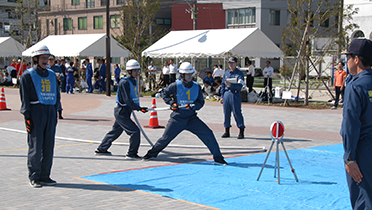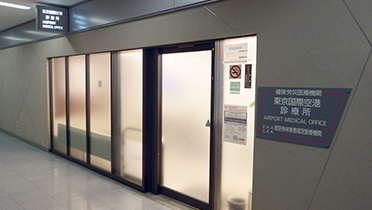- HOME
- Sustainability
- Social
- Safety and Security
- Efforts for Disaster Preparedness and Crime Prevention
Efforts for Disaster Preparedness and Crime Prevention
In line with our overarching goal of establishing “absolute safety,” we have set up a Disaster Prevention Center to manage the safety of the passenger terminals. It carries out various operations around the clock.
We strive to prevent incidents such as hijackings and acts of terrorism, and also to keep accidents from occurring. In the event of a disaster, accident, or incident, we have measures in place to ensure a swift and appropriate response. These include a comprehensive response manual, regularly scheduled joint training sessions with our Group companies and related departments, verified emergency communication protocols, and a stockpile of emergency supplies.
Aiming for a Unified Tenant Response

Through the Disaster Prevention Center, tenants join aviation security training sessions, receive disaster prevention and security news, and participate in various meetings. We regularly engage in educational activities, emphasizing to our tenants the significance of the passenger terminals’ public nature and the magnitude of the impact if its operations were to halt.
Furthermore, the Disaster Prevention Center serves as the administrative office for the Joint Fire Prevention Management Council, of which all tenants of the passenger terminals are members. We mandate participation in comprehensive disaster preparedness drills, and evacuation and fire extinguishing drills, and encourage attending first aid training courses. Our goal is to ensure that Disaster Prevention Center staff and all passenger terminal staff can respond promptly in the event of an emergency.
Promotion of Basic First Aid Training

The Disaster Prevention Center, acting as the administrative office for the Joint Fire Prevention and Disaster Management Council, carries out initiatives to promote basic first aid training courses for all tenant businesses, with our specially-trained staff providing instruction alongside emergency services personnel. Between April 1995 and March 2015, we conducted 165 first aid training courses, which were attended by about 2,030 people, including staff from tenant businesses and our own employees.
Moreover, all staff at the Disaster Prevention Center have completed advanced first aid training. Although retraining is typically undertaken every three years, the center’s staff take annual refresher courses to maintain and improve their first aid skills.
AEDs and SOS Emergency Phones

Since July 2004, automated external defibrillators (AEDs) have been accessible to the general public, not just medical professionals. In an effort to increase survival rates from serious cardiac complications like arrhythmias and ventricular fibrillation, 73 AEDs have been available in our facilities since December 2004: 33 in Terminal 1, 38 in Terminal 2, and two in the P1 and P4 parking lots.
Additionally, we’ve also set up SOS emergency phones that directly connect to the Disaster Prevention Center in most locations.
Volunteer Fire Brigade

We conduct regular evacuation and fire extinguishing drills at every store on the premises, as well as trainings with the local volunteer fire brigade. Moreover, a team that includes store and office volunteer fire brigade members actively participates in the Kamata Fire Station’s volunteer fire brigade training review sessions. The team has a high awareness of the importance of its firefighting activities, and its volunteers have won top awards. This commitment to fire safety is demonstrated daily in our operations.
Medical Facilities and Emergency Response

In addition to areas where individuals who may not be feeling well can rest for a while, we have set up several medical facilities, including the Tokyo International Medical Office and Terminal Dental Clinic in Terminal 1, as well as the Toho University Haneda Airport Clinic in Terminal 2.
In May 2002, a satellite station of the Kamata Fire Station Airport Substation was established on the first floor of Terminal 1. This allows for a rapid response from paramedics should there be an emergency call from within the terminal.
Earthquake Measures
To ensure the safety of customers in our buildings during an earthquake, we have prepared an earthquake disaster response manual and conduct regular earthquake drills.
For those who may need to remain in the buildings in the event of a serious earthquake, we maintain a stockpile of emergency supplies, including food, blankets, and portable toilets.
Additionally, since June 2008, we have provided earthquake early warnings in order to alert customers and employees in the terminals we manage with the aim of mitigating the effects of earthquakes. When we receive an earthquake early warning from the Japan Meteorological Agency indicating that an earthquake with a seismic intensity of around 5 or more is expected in the Haneda district, we make an emergency announcement throughout the buildings.
